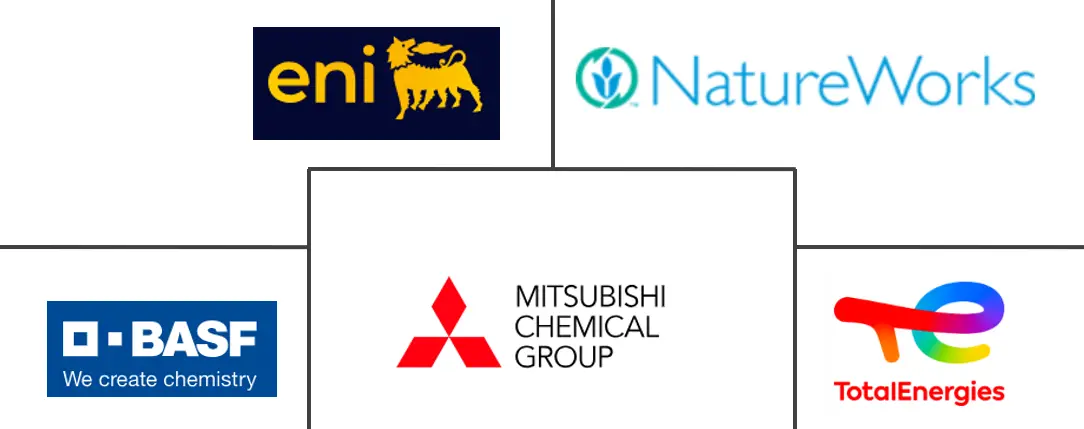Bio-degradable Polymers Market Size and Share
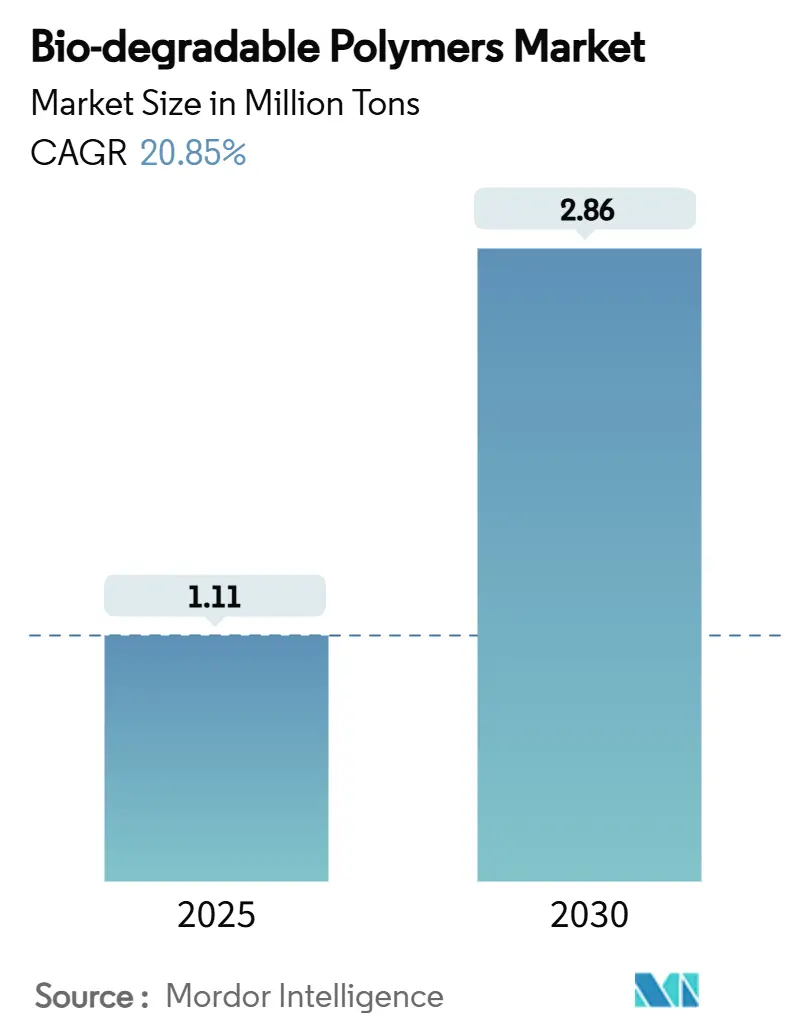
Bio-degradable Polymers Market Analysis by Mordor Intelligence
The Bio-degradable Polymers Market size is estimated at 1.11 Million tons in 2025, and is expected to reach 2.86 Million tons by 2030, at a CAGR of 20.85% during the forecast period (2025-2030). Heightened regulatory pressure, widening corporate sustainability goals, and rapid progress in microbial production technologies steer demand toward high-performance, low-carbon materials. Europe remains the largest regional consumer, while Asia-Pacific is advancing fastest due to industrial scale-up and supportive legislation. Product innovation now centers on marine-degradable grades and cost-efficient PHA, and competition is intensifying as petrochemical majors, specialty bioplastic firms, and start-ups invest simultaneously in capacity and research and development.
Key Report Takeaways
- By polymer type, starch-based plastics led with 41.05% of bio-degradable polymers market share in 2024, while PHA is projected to expand at a 23.49% CAGR through 2030.
- By feedstock, sugarcane and sugar beet commanded 38.14% share of the bio-degradable polymers market size in 2024; algal and microbial biomass are forecast to grow at a 24.56% CAGR.
- By end-user industry, packaging held 62.51% revenue share in 2024, whereas consumer goods is set to grow fastest at 23.60% CAGR to 2030.
- By geography, Europe captured a 39.19% share in 2024; Asia-Pacific is advancing at a 29.44% CAGR during 2025-2030.
Global Bio-degradable Polymers Market Trends and Insights
Driver Impact Analysis
| Drivers | (~) % Impact on CAGR Forecast | Geographic Relevance | Impact Timeline |
|---|---|---|---|
| Regulations against single-use plastics | +2.6% | Europe, North America, Japan, South Korea, China, India | Medium term (2-4 years) |
| Consumer demand for sustainable packaging | +1.9% | Global; strongest in Europe, North America | Short term (≤2 years) |
| Rising healthcare applications | +1.3% | North America, Europe, Japan | Medium term (2-4 years) |
| Agricultural film adoption | +1.0% | Asia-Pacific, Europe, Latin America | Medium term (2-4 years) |
| Process innovations that cut costs | +0.8% | Europe, North America, Japan | Long term (≥4 years) |
| Source: Mordor Intelligence | |||
Government Regulations Against Single-Use Plastics
Global rulemaking is reshaping material flows. The European Union’s Packaging and Packaging Waste Regulation, finalized in 2024, obliges all packaging sold in the bloc to be recyclable and sets stepwise waste-reduction targets, immediately directing converters toward certified compostable or recyclable grades[1]European Parliament, “Packaging and Packaging Waste,” europarl.europa.eu. The UK’s ban on wet wipes containing plastic, introduced in April 2024, further enlarges the hygiene-product opportunity. Hong Kong’s 2024 prohibition on single-use items such as straws and EPS containers signals similar momentum in Asia. Together, these measures are shortening payback periods for new polymer plants, accelerating off-take agreements, and incentivizing downstream brand adoption.
Growing Demand for Sustainable Packaging
Brand owners now treat sustainability as a growth driver rather than a compliance exercise. Premium food and beverage producers are shifting to PLA, PHA, and coated paper structures that lower end-of-life emissions. Laboratory evidence from the University of Portsmouth shows PLA emits nine times fewer microplastics under seawater-sunlight exposure than conventional PP, improving brand reputations among ocean-minded consumers. Design-for-recyclability guidelines and e-commerce expansion add to the pull, creating high-volume demand pockets for films, trays, and rigid containers.
Increasing Adoption in the Healthcare Industry
Medical device makers are exploiting controlled-degradation profiles of PLA, PGA, and PCL in resorbable sutures, scaffolds, and drug-delivery depots. Taipei Medical University’s chitosan-dextran adhesive (ChitHCl-DDA) demonstrates strong bonding for knee-meniscus repair while degrading safely in vivo. Likewise, near-infrared-responsive 3D-printed PLA/PCL scaffolds enable shape-memory bone implants with on-demand actuation. Such breakthroughs attract premium pricing and diversify revenue beyond packaging.
Surge in Agricultural Films Usage
Farmers in China, Spain, and Italy are shifting to biodegradable mulch and seed-coating systems that suppress weeds and eliminate costly retrieval of conventional PE films. Applied Sciences reports rapid decomposition of fiber–starch films, aligning with seasonal crop cycles. Government subsidies for low-carbon agriculture magnify demand, and the Asia-Pacific bio-degradable polymers market now counts agriculture among its top three outlets.
Restraint Impact Analysis
| Restraints | (~) % Impact on CAGR Forecast | Geographic Relevance | Impact Timeline |
|---|---|---|---|
| High production cost | -1.8% | Global, highest in price-sensitive Asian and Latin American markets | Medium term (2-4 years) |
| Limited mechanical performance | -1.2% | Global, critical in automotive and construction | Medium term (2-4 years) |
| Lack of industrial composting infrastructure | -0.9% | Developing regions | Long term (≥4 years) |
| Source: Mordor Intelligence | |||
High Production Cost
Equipment amortization, specialty feedstocks, and modest plant scales keep average selling prices above commodity PE and PP. The bankruptcy filing of Danimer Scientific in 2025 underscores profitability headwinds even for technology leaders. While increased capacity and process intensification are driving costs down, many converters still hesitate to commit to mass-market packaging segments.
Limited Mechanical Performance
Tensile strength and heat-deflection temperatures lag those of engineering plastics, blocking entry into load-bearing automotive or construction parts. Studies show PLA/PP blends, though partially biodegradable, retain only 99.89% weight after 45 days, yet still fall short of long-term mechanical integrity targets. Formulators are responding with stereocomplex PLA, chain extenders, and fiber reinforcement, but engineering challenges remain.
Segment Analysis
By Polymer Type: Starch Blends Retain Lead, While PHA Accelerates
Starch-based grades hold 41.05% of the bio-degradable polymers market share due to abundant feedstock and compatibility with existing blown-film and thermoforming lines. PLA maintains a robust position in rigid packaging and medical devices. The bio-degradable polymers market size for PHA is projected to grow at a 23.49% CAGR, aided by its rapid marine degradation profile and improvements in microbial fermentation yields. Polyester families such as PBS and PBAT are gaining share in cling films and hygiene backsheets, while cellulosic derivatives serve coatings and paper cups.
Cost parity remains elusive. Starch blends enjoy agricultural subsidies and simpler compounding, but PHA developers benefit from carbon-capture credits and high-margin medical sales. A foreseeable convergence toward blended systems may deliver balanced cost-performance.
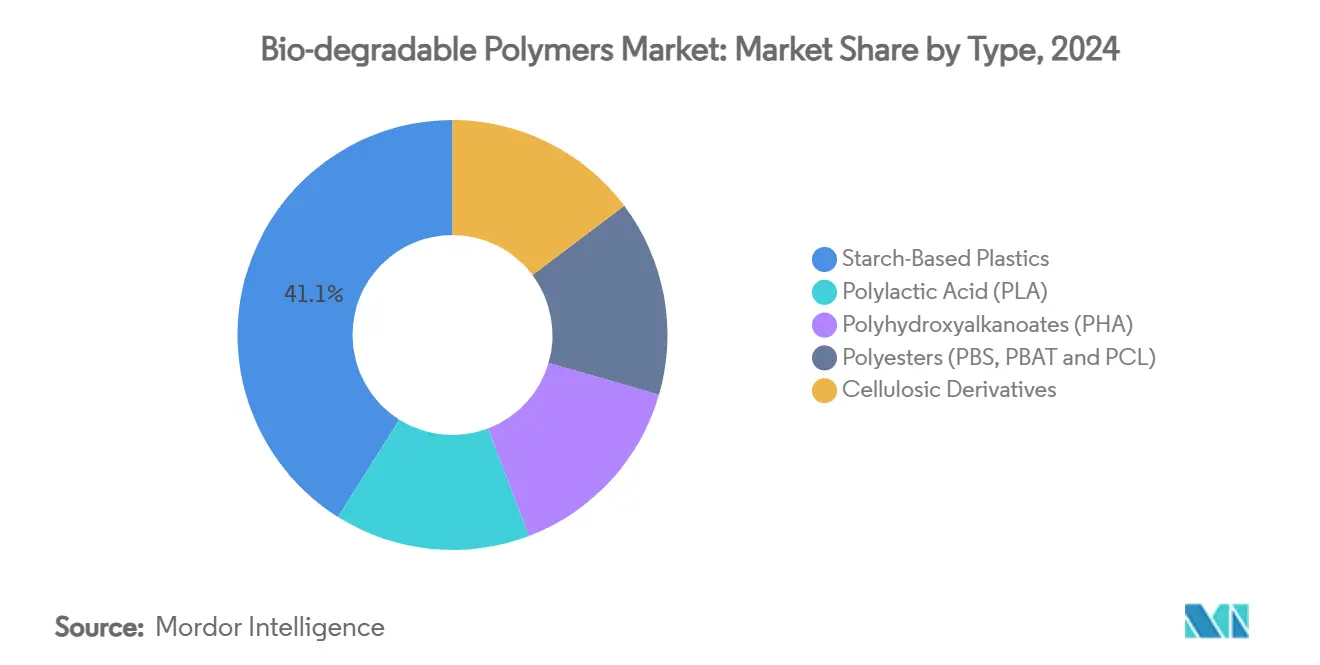
Note: Segment shares of all individual segments available upon report purchase
By Feedstock: Sugar Crops Dominant, Microbial and Algal Sources Surge
Sugarcane and beet processing chains account for 38.14% of global feedstock thanks to established mills in Brazil, Thailand, and France. The bio-degradable polymers market size derived from algal and microbial biomass is set to grow at 24.56% CAGR, reflecting non-food competition, high lipid productivity, and wastewater-tolerant cultivation. Lignocellulosic routes are advancing: carbon-dioxide/epoxide copolymerization using lignocellulose-derived monomers yields biodegradable polycarbonates with negative carbon footprints.
Feedstock choice is becoming strategic; regions with surplus bagasse or forestry residue can secure low-cost monomers, while coastal nations exploit algae for both carbon sequestration and polymer output.
By End-User Industry: Packaging Commands Volume, Consumer Goods Race Ahead
Packaging held a 62.51% share in 2024, as regulatory bans and e-commerce expansion created an immediate pull for compostable films, trays, and laminates. The bio-degradable polymers market size allocated to consumer goods, spanning durable housewares, electronics casings, and toys, is forecast to grow at 23.60% CAGR, lifted by brand pledges for carbon-neutral products and improved heat-deflection grades. Textiles benefit from PLA-based staple fibers, giving apparel makers a low-shedding, low-carbon alternative. Agriculture continues to widen adoption of mulch and controlled-release films, while healthcare captures premium margins via implants and drug depots such as hybrid PLGA/pHEMA systems offering 32-day release profiles.
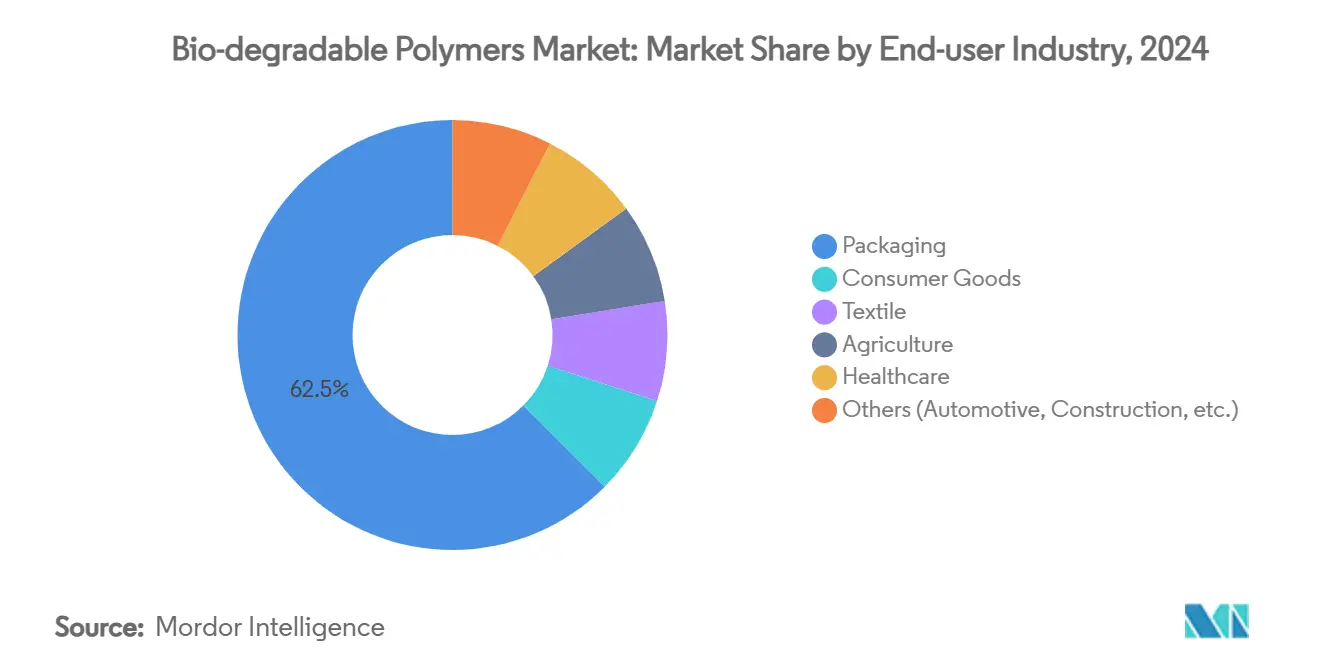
Note: Segment shares of all individual segments available upon report purchase
Geography Analysis
Europe’s 39.19% leadership stems from policy clarity and consumer eco-awareness. The EU regulation finalized in 2024 forces recyclable or compostable packaging, and landmark projects such as Fortum’s CO₂-to-polymer plant in Finland illustrate how carbon capture integrates with bio-based production.
Asia-Pacific is the fastest-growing region at 29.44% CAGR. China ramps up PHA and PBAT plants to meet national plastic-ban deadlines and to supply agriculture films. Japan innovates marine-degradable PBS incorporating disulfide bonds for ocean buoy applications[2]Ken-ichi Kasuya, “Marine biodegradation of PBS,” pubs.acs.org.
North America combines technological innovation with voluntary corporate targets. Dow’s agreement with New Energy Blue uses corn stover to make bio-ethylene for PE assets, opening a low-carbon drop-in path. South America and the Middle East remain nascent but show interest in biodegradable mulch to reduce field-burning. Lack of industrial composting facilities curbs immediate uptake yet signals long-term infrastructure opportunities.
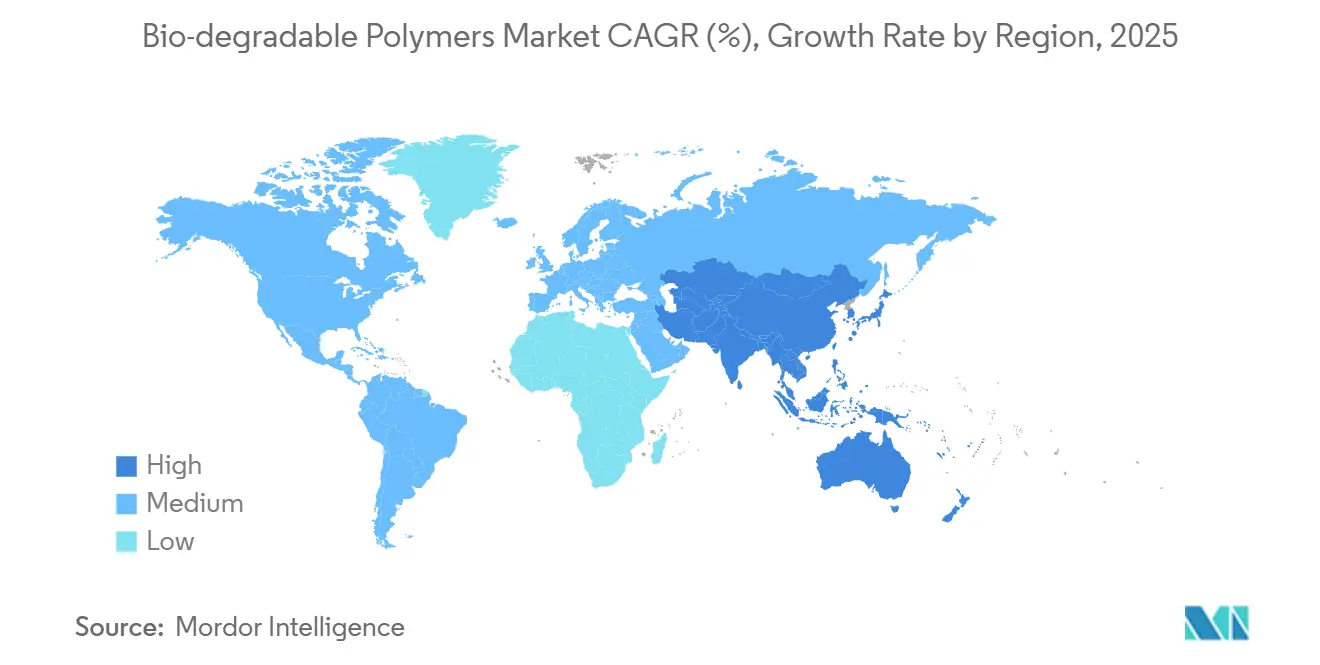
Competitive Landscape
The market displays high fragmentation. Novamont, a subsidiary of Eni S.p.A., continues to license Mater-Bi technology to film extruders across Europe. NatureWorks broke ground on a fully integrated PLA complex in Thailand, expected to be on-stream in 2025. CJ Biomaterials introduced PHA bottle caps displaying high barrier and twist-retention properties, addressing hot-fill beverage demands.
Bio-degradable Polymers Industry Leaders
-
NatureWorks LLC
-
TotalEnergies (Total Corbion)
-
Eni S.p.A. (Novamont)
-
BASF
-
Mitsubishi Chemical Group Corporation
- *Disclaimer: Major Players sorted in no particular order

Recent Industry Developments
- March 2025: NatureWorks LLC launched Ingeo Extend PLA for biaxially oriented films and began construction of its Thailand PLA complex.
- March 2025: TotalEnergies Corbion introduced the first recycled-content PLA grade and joined the Greco project to develop new copolymers for food packaging.
Global Bio-degradable Polymers Market Report Scope
Bio-degradable polymers are produced both naturally and synthetically, mostly consisting of different functional groups such as ester, amide, and other functional groups. These polymers are also increasingly used for various applications due to less or no carbon footprint.
The bio-degradable polymers market is segmented by product type, end-user industry, and geography. By product type, the market is segmented into starch-based plastics, polylactic acid, polyhydroxyalkanoates, and cellulose derivatives. By end-user industry, the market is segmented into agriculture, textile, consumer goods, packaging, healthcare, and other end-user industries. The report also covers the market size and forecasts for the bio-degradable polymers market in 15 countries across major regions.
For each segment, the market sizing and prediction have been made based on volume (tons).
| Starch-Based Plastics |
| Polylactic Acid (PLA) |
| Polyhydroxyalkanoates (PHA) |
| Polyesters (PBS, PBAT and PCL) |
| Cellulosic Derivatives |
| Sugarcane and Sugar Beets |
| Corn and Other Starch Crops |
| Cellulose and Wood Biomass |
| Waste Vegetable Oils and Fats |
| Algal and Microbial Biomass |
| Packaging |
| Consumer Goods |
| Textile |
| Agriculture |
| Healthcare |
| Others (Automotive, Construction, etc.) |
| Asia-Pacific | China |
| India | |
| Japan | |
| South Korea | |
| ASEAN | |
| Rest of Asia-Pacific | |
| North America | United States |
| Canada | |
| Mexico | |
| Europe | Germany |
| United Kingdom | |
| France | |
| Italy | |
| Rest of Europe | |
| South America | Brazil |
| Argentina | |
| Rest of South America | |
| Middle-East and Africa | Saudi Arabia |
| South Africa | |
| Rest of Middle-East and Africa |
| By Type | Starch-Based Plastics | |
| Polylactic Acid (PLA) | ||
| Polyhydroxyalkanoates (PHA) | ||
| Polyesters (PBS, PBAT and PCL) | ||
| Cellulosic Derivatives | ||
| By Feedstock | Sugarcane and Sugar Beets | |
| Corn and Other Starch Crops | ||
| Cellulose and Wood Biomass | ||
| Waste Vegetable Oils and Fats | ||
| Algal and Microbial Biomass | ||
| By End-user Industry | Packaging | |
| Consumer Goods | ||
| Textile | ||
| Agriculture | ||
| Healthcare | ||
| Others (Automotive, Construction, etc.) | ||
| By Geography | Asia-Pacific | China |
| India | ||
| Japan | ||
| South Korea | ||
| ASEAN | ||
| Rest of Asia-Pacific | ||
| North America | United States | |
| Canada | ||
| Mexico | ||
| Europe | Germany | |
| United Kingdom | ||
| France | ||
| Italy | ||
| Rest of Europe | ||
| South America | Brazil | |
| Argentina | ||
| Rest of South America | ||
| Middle-East and Africa | Saudi Arabia | |
| South Africa | ||
| Rest of Middle-East and Africa | ||
Key Questions Answered in the Report
What is the current size of the biodegradable polymers market?
The market reached 1.11 million tons in 2025 and is projected to climb to 2.86 million tons by 2030.
Which region leads the bio-degradable polymers market?
Europe holds the largest share at 39.19%, driven by stringent packaging regulations and strong consumer eco-awareness.
What polymer type is growing fastest?
Polyhydroxyalkanoates (PHA) are forecast to expand at a 23.49% CAGR due to superior biodegradability across soil and marine environments.
Why are costs still a restraint?
Bio-degradable polymers generally cost more than commodity plastics because of smaller plant scales, specialized feedstocks, and complex processing.
Page last updated on:
